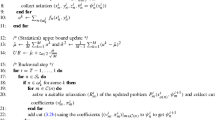Abstract
We study a single-machine scheduling problem with two allowable job release and delivery times. This special case of a strongly NP-hard single-machine scheduling problem with an arbitrary number of job release and delivery times and with the objective to minimize the maximum job completion time remains NP-hard. Nevertheless, it is more transparent and accessible than the general version. Hence, it permitted us to establish some nice properties that yielded simple and efficient solution methods. On the one hand, the restricted setting is useful by its own right since it fits some real-life applications. On the other hand, the presented case study is helpful in the solution of a more general setting with a constant number of job release and delivery times. In particular, the optimality conditions and the heuristics methods that we propose here for the restricted setting might be generalized to the extended setting. The established optimality criteria are explicit conditions under which the restricted problem can be solved optimally in time \(O(n\log n)\). The extensive computational study showed that at least one of these conditions is satisfied for practically all the randomly generated 50 million problem instances while applying our heuristics to these instances. We report a favorable practical performance of our polynomial-time subroutine that invokes our five heuristics and verifies the proposed optimality conditions consecutively. These conditions were verified for the solutions delivered by the five heuristics individually and in a combined fashion as four pairs of heuristics and as all the five heuristics together. Fifty million problem instances were randomly generated using uniform distribution for each of these ten combinations. For the 50 million instances generated for the last (overall) combination, the schedule created by at least one of the heuristics has satisfied at least one of our optimality conditions (so all these problem instances were solved optimally). We also addressed the (theoretical) possibility that none of our conditions is satisfied, and showed how a known dynamic programming algorithm for SUBSET SUM problem can be used for the solution of the scheduling problem in pseudo-polynomial time. For a considerable part of the tested instances, one of the five scheduling heuristics has solved optimally also SUBSET SUM problem.
Similar content being viewed by others
References
Bratley, P., Florian, M., & Robillard, P. (1973). On sequencing with earliest start times and due-dates with application to computing bounds for (\({n/m/G/{F}_{max} }\)) problem. Naval Research Logistics Quarterly, 20, 57–67.
Chinos, E., & Vakhania, N. (2017). Adjusting scheduling model with release and due dates in production planning. Cogent Engineering, 4(1), 1–23. https://doi.org/10.1080/23311916.2017.1321175
Garey, M. R., & Johnson, D. S. (1979). Computers and Intractability: A Guide to the Theory of NP-completeness (pp. 1–340). San Francisco: Freeman.
Garey, M. R., Johnson, D. S., Simons, B. B., & Tarjan, R. E. (1981). Scheduling unit-time tasks with arbitrary release times and deadlines. SIAM Journal on Computing, 10, 256–269.
Graham, R. L., Lawler, E. L., Lenstra, J. L., & Rinnooy Kan, A. H. G. (1979). Optimization and approximation in deterministic sequencing and scheduling: a servey. Annals of Discrete Mathematics, 5, 287–326.
Hall, L. A., & Shmoys, D. B. (1992). Jacksons rule for single-machine scheduling: Making a good heuristic better. Mathematics of Operations Research, 17, 22–35.
Jackson, J. R. (1955). Schedulig a production line to minimize the maximum tardiness. Manegement Scince Research Project, University of California, Los Angeles, CA.
Lazarev, A. A., & Arkhipov, D. I. (2016). Minimization of the maximal lateness for a single machine. Automation and Remote Control, 77, 656–671.
Nowicki, E., & Smutnicki, C. (1994). An approximation algorithm for a single-machine scheduling problem with release times and delivery times. Discrete Applied Mathematics, 48, 69–79.
Potts, C. N. (1980). Analysis of a heuristic for one machine sequencing with release dates and delivery times. Operations Research, 28, 1436–1441.
Schrage, L. (1971). Obtaining optimal solutions to resource constrained network scheduling problems (unpublished manuscript).
Vakhania, N. (2003). A better algorithm for sequencing with release and delivery times on identical processors. Journal of Algorithms, 48, 273–293.
Vakhania, N. (2004). Single-machine scheduling with release times and tails. Annals of Operations Research, 129, 253–271.
Vakhania, N., & Werner, F. (2013). Minimizing maximum lateness of jobs with naturally bounded job data on a single machine in polynomial time. Theoretical Computer Science, 501, 72–81. https://doi.org/10.1016/j.tcs.2013.07.001
Vakhania, N., Perez, D., & Carballo, L. (2015). Theoretical expectation versus practical performance of Jacksons heuristic. Mathematical Problems in Engineering, 2015, 1–10. https://doi.org/10.1155/2015/484671
Vakhania, N. (2019). Fast solution of single-machine scheduling problem with embedded jobs. Theoretical Computer Science, 782, 91–106. https://doi.org/10.1016/j.tcs.2019.03.001
Vakhania, N. (2019). Dynamic restructuring framework for scheduling with release times and due-dates. Mathematics, 7(11), 1–40. https://doi.org/10.3390/math7111104
Acknowledgements
The authors are grateful to the referees and the editors for the patient and consistent comments which were especially helpful for improving the presentation.
Author information
Authors and Affiliations
Corresponding author
Additional information
Publisher's Note
Springer Nature remains neutral with regard to jurisdictional claims in published maps and institutional affiliations.
Appendix
Appendix
See Tables 12, 13, 14, 15, 16, 17, 18, 19, 20 and 21.
Rights and permissions
About this article
Cite this article
Reynoso, A., Vakhania, N. Theoretical and practical issues in single-machine scheduling with two job release and delivery times. J Sched 24, 615–647 (2021). https://doi.org/10.1007/s10951-021-00708-4
Accepted:
Published:
Issue Date:
DOI: https://doi.org/10.1007/s10951-021-00708-4




